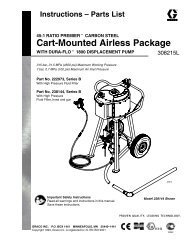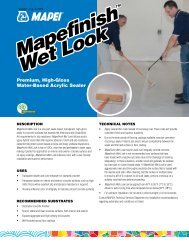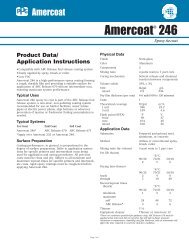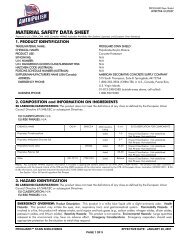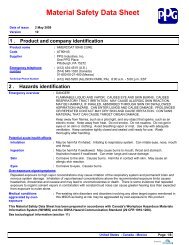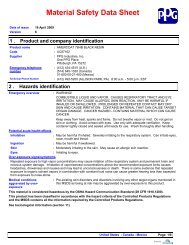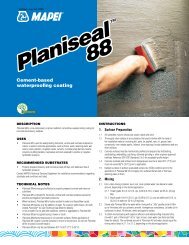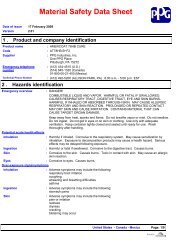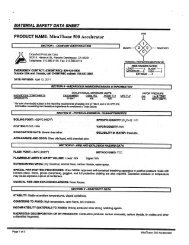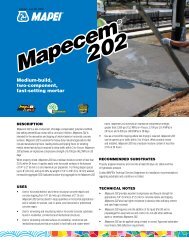Material Safety Data Sheet - AltaPaints and Coatings
Material Safety Data Sheet - AltaPaints and Coatings
Material Safety Data Sheet - AltaPaints and Coatings
Create successful ePaper yourself
Turn your PDF publications into a flip-book with our unique Google optimized e-Paper software.
<strong>Material</strong> <strong>Safety</strong> <strong>Data</strong> <strong>Sheet</strong>Date of issue 28 April 2009Version 6.011 .Product <strong>and</strong> company identificationProduct nameCodeSupplierEmergency telephonenumberTechnical Phone Number: AMERCOAT 741 BLACK: AT741-9::PPG Industries, Inc.One PPG PlacePittsburgh, PA 15272(412) 434-4515 (U.S.)(514) 645-1320 (Canada)01-800-00-21-400 (Mexico): (412) 492-5200 (ALLISON PARK, PA) 8:00 a.m. - 5:00 p.m. EST2 .Hazards identificationEmergency overviewPotential acute health effectsInhalationIngestionSkinEyesMedical conditionsaggravated by overexposureSee toxicological information (section 11): WARNING!FLAMMABLE LIQUID AND VAPOR. HARMFUL IF INHALED. CAUSESRESPIRATORY TRACT AND EYE IRRITATION. MAY BE HARMFUL IFSWALLOWED. SANDING AND GRINDING DUSTS MAY BE HARMFUL IF INHALED.PROLONGED OR REPEATED CONTACT MAY DRY SKIN AND CAUSE IRRITATION.CONTAINS MATERIAL THAT CAN CAUSE TARGET ORGAN DAMAGE.:::::Keep away from flames, such as a pilot light, <strong>and</strong> any object that sparks, such as anelectric motor. Keep away from heat. Do not smoke. Do not breathe vapor or mist.Avoid contact with eyes, skin <strong>and</strong> clothing. Use only with adequate ventilation. Keepcontainer tightly closed <strong>and</strong> sealed until ready for use. Wash thoroughly after h<strong>and</strong>ling.Harmful if inhaled. Severely irritating to the respiratory system. Can irritate eyes, nose,mouth <strong>and</strong> throat.May be harmful if swallowed.Moderately irritating to the skin.Irritating to eyes.Over-exposure signs/symptomsRepeated exposure to high vapor concentrations may cause irritation of the respiratory system <strong>and</strong> permanent brain <strong>and</strong>nervous system damage. Inhalation of vapor/aerosol concentrations above the recommended exposure limits causesheadaches, drowsiness <strong>and</strong> nausea <strong>and</strong> may lead to unconsciousness or death. There is some evidence that repeatedexposure to organic solvent vapors in combination with constant loud noise can cause greater hearing loss than expectedfrom exposure to noise alone.Pre-existing disorders involving any target organs mentioned in this MSDS as being atrisk may be aggravated by over-exposure to this product.This <strong>Material</strong> <strong>Safety</strong> <strong>Data</strong> <strong>Sheet</strong> has been prepared in accordance with Canada's Workplace Hazardous <strong>Material</strong>sInformation System (WHMIS) <strong>and</strong> the OSHA Hazard Communication St<strong>and</strong>ard (29 CFR 1910.1200).United States - Canada - MexicoPage: 1/9
Product code AT741-9 Date of issue 28 April 2009 VersionProduct name AMERCOAT 741 BLACK6.013 .Composition/information on ingredientsName CAS number %Cement, portl<strong>and</strong>, chemicals 65997-15-1 30 - 60Silicic acid, ethyl ester 11099-06-2 10 - 30solvent naphtha (petroleum), light arom. 64742-95-6 5 - 10c.i. pigment black 26 68186-94-7 3 - 7glass, oxide, chemicals 65997-17-3 3 - 71,2,4-trimethylbenzene 95-63-6 1 - 5tetraethyl silicate 78-10-4 1 - 5titanium tetrakis(2-ethylhexanolate) 1070-10-6 1 - 5mesitylene 108-67-8 0.5 - 1.5ethanol 64-17-5 0.1 - 1xylene (mixture of o-, m-, p-isomers) 1330-20-7 0.1 - 1There are no additional ingredients present which, within the current knowledge of the supplier <strong>and</strong> in theconcentrations applicable, are classified as hazardous to health or the environment <strong>and</strong> hence require reporting inthis section.4 .First aid measuresIf ingestion, irritation, any type of overexposure or symptoms of overexposure occur during or persists after use of thisproduct, contact a POISON CONTROL CENTER, EMERGENCY ROOM OR PHYSICIAN immediately; have <strong>Material</strong><strong>Safety</strong> <strong>Data</strong> <strong>Sheet</strong> information available. Never give anything by mouth to an unconscious or convulsing person.Eye contactSkin contactInhalationIngestionNotes to physician5 .Fire-fighting measuresFlammability of the product :Extinguishing mediaSuitable :Not suitable :Special exposure hazards :Hazardous combustionproductsSpecial protectiveequipment for fire-fighters::::::Check for <strong>and</strong> remove any contact lenses. Immediately flush eyes with running waterfor at least 15 minutes, keeping eyelids open.Remove contaminated clothing <strong>and</strong> shoes. Wash skin thoroughly with soap <strong>and</strong>water or use recognized skin cleanser. Do not use solvents or thinners.Remove to fresh air. Keep person warm <strong>and</strong> at rest. If not breathing, if breathing isirregular or if respiratory arrest occurs, provide artificial respiration or oxygen bytrained personnel.If swallowed, seek medical advice immediately <strong>and</strong> show this container or label.Keep person warm <strong>and</strong> at rest. Do not induce vomiting.No specific treatment. Treat symptomatically. Contact poison treatment specialistimmediately if large quantities have been ingested or inhaled.Flammable liquid. In a fire or if heated, a pressure increase will occur <strong>and</strong> the containermay burst, with the risk of a subsequent explosion. Vapors may accumulate in low orconfined areas or travel a considerable distance to a source of ignition <strong>and</strong> flash back.Runoff to sewer may create fire or explosion hazard.Use dry chemical, CO2, water spray (fog) or foam.Do not use water jet.Promptly isolate the scene by removing all persons from the vicinity of the incident ifthere is a fire. No action shall be taken involving any personal risk or without suitabletraining. Move containers from fire area if this can be done without risk. Use waterspray to keep fire-exposed containers cool.: Decomposition products may include the following materials:carbon oxidesmetal oxide/oxidesFire-fighters should wear appropriate protective equipment <strong>and</strong> self-contained breathingapparatus (SCBA) with a full face-piece operated in positive pressure mode.United States - Canada - MexicoPage: 2/9
Product code AT741-9 Date of issue 28 April 2009 VersionProduct name AMERCOAT 741 BLACK6.016 .Accidental release measuresPersonal precautions :Environmental precautionsLarge spill :Small spill :7 .H<strong>and</strong>lingH<strong>and</strong>ling <strong>and</strong> storage:No action shall be taken involving any personal risk or without suitable training.Evacuate surrounding areas. Keep unnecessary <strong>and</strong> unprotected personnel fromentering. Do not touch or walk through spilled material. Shut off all ignition sources. Noflares, smoking or flames in hazard area. Avoid breathing vapor or mist. Provideadequate ventilation. Wear appropriate respirator when ventilation is inadequate. Puton appropriate personal protective equipment (see section 8).: Avoid dispersal of spilled material <strong>and</strong> runoff <strong>and</strong> contact with soil, waterways, drains<strong>and</strong> sewers. Inform the relevant authorities if the product has caused environmentalpollution (sewers, waterways, soil or air).Stop leak if without risk. Move containers from spill area. Approach release fromupwind. Use spark-proof tools <strong>and</strong> explosion-proof equipment. Prevent entry intosewers, water courses, basements or confined areas. Wash spillages into an effluenttreatment plant or proceed as follows. Contain <strong>and</strong> collect spillage with noncombustible,absorbent material e.g. s<strong>and</strong>, earth, vermiculite or diatomaceous earth <strong>and</strong>place in container for disposal according to local regulations (see section 13). Disposeof via a licensed waste disposal contractor. Contaminated absorbent material may posethe same hazard as the spilled product. Note: see section 1 for emergency contactinformation <strong>and</strong> section 13 for waste disposal.Stop leak if without risk. Move containers from spill area. Use spark-proof tools <strong>and</strong>explosion-proof equipment. Dilute with water <strong>and</strong> mop up if water-soluble or absorb withan inert dry material <strong>and</strong> place in an appropriate waste disposal container. Dispose ofvia a licensed waste disposal contractor.Put on appropriate personal protective equipment (see section 8). Eating, drinking <strong>and</strong>smoking should be prohibited in areas where this material is h<strong>and</strong>led, stored <strong>and</strong>processed. Do not breathe vapor or mist. Do not swallow. Do not get in eyes or on skinor clothing. Use only with adequate ventilation. Wear appropriate respirator whenventilation is inadequate. Do not enter storage areas <strong>and</strong> confined spaces unlessadequately ventilated. Keep in the original container or an approved alternative madefrom a compatible material, kept tightly closed when not in use. Store <strong>and</strong> use awayfrom heat, sparks, open flame or any other ignition source. Use explosion-proofelectrical (ventilating, lighting <strong>and</strong> material h<strong>and</strong>ling) equipment. Use non-sparking tools.Take precautionary measures against electrostatic discharges. Vapors are heavier thanair <strong>and</strong> may spread along floors. To avoid fire or explosion, dissipate static electricityduring transfer by grounding <strong>and</strong> bonding containers <strong>and</strong> equipment before transferringmaterial. Empty containers retain product residue <strong>and</strong> can be hazardous. Do not reusecontainer. If this material is part of a multiple component system, read the <strong>Material</strong><strong>Safety</strong> <strong>Data</strong> <strong>Sheet</strong>(s) for the other component or components before blending as theresulting mixture may have the hazards of all of its parts.Storage:Store in accordance with local regulations. Store in a segregated <strong>and</strong> approved area.Store in original container protected from direct sunlight in a dry, cool <strong>and</strong> well-ventilatedarea, away from incompatible materials (see section 10) <strong>and</strong> food <strong>and</strong> drink. Eliminateall ignition sources. Separate from oxidizing materials. Keep container tightly closed<strong>and</strong> sealed until ready for use. Containers that have been opened must be carefullyresealed <strong>and</strong> kept upright to prevent leakage. Do not store in unlabeled containers. Useappropriate containment to avoid environmental contamination. Do not store above thefollowing temperature: 120F / 49C.United States - Canada - MexicoPage: 3/9
Product code AT741-9 Date of issue 28 April 2009 VersionProduct name AMERCOAT 741 BLACK8 .Exposure controls/personal protection6.01Name Result ACGIH OSHA Ontario Mexico PPGCement, portl<strong>and</strong>, chemicals TWA 10 mg/m³ 5 mg/m³ R15 mg/m³ TD10 mg/m³ TD 10 mg/m³ NotestablishedSTEL NotestablishedNotestablishedNotestablished20 mg/m³ Notestablished____________________________ ___________ ___________ ___________ ___________ ___________ ___________c.i. pigment black 26 TWA 0.2 mg/m³(as Mn)Notestablished0.2 mg/m³(manganese)0.2 mg/m³(as Mn)NotestablishedSTEL Notestablished5 mg/m³ C5 mg/m³ (asNotestablishedNotestablishedNotestablishedMn) C____________________________ ___________ ___________ ___________ ___________ ___________ ___________glass, oxide, chemicals TWA 10 MG/M3TD15 mg/m3TDNotestablishedNotestablishedNotestablished3 MG/M3 R1 f/cc5 mg/m³(Inhalable)5 mg/m3 R15 mg/m3____________________________ ___________ ___________ ___________ ___________ ___________ ___________1,2,4-trimethylbenzene TWA 25 ppm Notestablished25 ppm 25 ppm NotestablishedSTEL NotestablishedNotestablishedNotestablished35 ppm Notestablished____________________________ ___________ ___________ ___________ ___________ ___________ ___________tetraethyl silicate TWA 10 ppm 100 ppm 10 ppm 10 ppm NotestablishedSTEL NotestablishedNotestablishedNotestablished30 ppm Notestablished____________________________ ___________ ___________ ___________ ___________ ___________ ___________mesitylene TWA 25 ppm Notestablished25 ppm 25 ppm NotestablishedSTEL NotestablishedNotestablishedNotestablished35 ppm Notestablished____________________________ ___________ ___________ ___________ ___________ ___________ ___________ethanol TWA 1000 ppm 1000 ppm 1000 ppm 1000 ppm Notestablished____________________________ ___________ ___________ ___________ ___________ ___________ ___________xylene (mixture of o-, m-, p-isomers)TWA 100 ppm 100 ppm 100 ppm 100 ppm NotestablishedSTEL 150 ppm Notestablished150 ppm 150 ppm Notestablished____________________________ ___________ ___________ ___________ ___________ ___________ ___________Key to abbreviationsA = Acceptable Maximum PeakS = Potential skin absorptionACGIH = American Conference of Governmental Industrial Hygienists. SR = Respiratory sensitizationC = Ceiling LimitSS = Skin sensitizationF = FumeTD = Total dustIPEL = Internal Permissible Exposure LimitTLV = Threshold Limit ValueOSHA = Occupational <strong>Safety</strong> <strong>and</strong> Health Administration.TWA = Time Weighted AverageR = Respirable Z = OSHA 29CFR 1910.1200 Subpart Z - Toxic <strong>and</strong> HazardousSubstancesConsult local authorities for acceptable exposure limits.United States - Canada - MexicoPage: 4/9
Product code AT741-9 Date of issue 28 April 2009 VersionProduct name AMERCOAT 741 BLACK8 .Exposure controls/personal protectionRecommended monitoringproceduresEngineering measuresHygiene measuresPersonal protectionEyesH<strong>and</strong>sRespiratorySkinEnvironmental exposurecontrols: If this product contains ingredients with exposure limits, personal, workplace atmosphereor biological monitoring may be required to determine the effectiveness of the ventilationor other control measures <strong>and</strong>/or the necessity to use respiratory protective equipment.: Use only with adequate ventilation. Use process enclosures, local exhaust ventilation orother engineering controls to keep worker exposure to airborne contaminants below anyrecommended or statutory limits. The engineering controls also need to keep gas, vaporor dust concentrations below any lower explosive limits. Use explosion-proof ventilationequipment.: Wash h<strong>and</strong>s, forearms <strong>and</strong> face thoroughly after h<strong>and</strong>ling chemical products, beforeeating, smoking <strong>and</strong> using the lavatory <strong>and</strong> at the end of the working period. Appropriatetechniques should be used to remove potentially contaminated clothing. Washcontaminated clothing before reusing. Ensure that eyewash stations <strong>and</strong> safety showersare close to the workstation location.:::<strong>Safety</strong> glasses with side shields.: Chemical-resistant, impervious gloves complying with an approved st<strong>and</strong>ard should beworn at all times when h<strong>and</strong>ling chemical products if a risk assessment indicates this isnecessary.6.01If workers are exposed to concentrations above the exposure limit, they must useappropriate, certified respirators. Use a properly fitted, air-purifying or air-fed respiratorcomplying with an approved st<strong>and</strong>ard if a risk assessment indicates this is necessary.Respirator selection must be based on known or anticipated exposure levels, thehazards of the product <strong>and</strong> the safe working limits of the selected respirator.Personal protective equipment for the body should be selected based on the task beingperformed <strong>and</strong> the risks involved <strong>and</strong> should be approved by a specialist before h<strong>and</strong>lingthis product.: Emissions from ventilation or work process equipment should be checked to ensure theycomply with the requirements of environmental protection legislation. In some cases,fume scrubbers, filters or engineering modifications to the process equipment will benecessary to reduce emissions to acceptable levels.9 .Physical <strong>and</strong> chemical propertiesPhysical stateFlash pointSpecific gravity: 1.75Density ( lbs / gal ) : 14.6: Liquid.: Closed cup: 18.33°C (65°F)Explosion limits : Lower: 2.4%Color: Not available.OdorpHBoiling/condensation pointMelting/freezing pointVapor pressureVapor densityVolatilityOdor thresholdEvaporation rate:::::::::Not available.Not available.>37.78°C (>100°F)Not available.3.1 kPa (23.4 mm Hg)Not available.43% (v/v), 21.35% (w/w)Not available.112 (Butyl acetate. = 1)United States - Canada - MexicoPage: 5/9
Product code AT741-9 Date of issue 28 April 2009 VersionProduct name AMERCOAT 741 BLACK9 .Physical <strong>and</strong> chemical propertiesOctanol/water partitioncoefficient: Not available.% Solid. (w/w) : 78.656.0110 .StabilityStability <strong>and</strong> reactivityConditions to avoid<strong>Material</strong>s to avoidHazardous decompositionproductsHazardous polymerization:::::Stable under recommended storage <strong>and</strong> h<strong>and</strong>ling conditions (see section 7).Avoid all possible sources of ignition (spark or flame). Do not pressurize, cut, weld,braze, solder, drill, grind or expose containers to heat or sources of ignition.Reactive or incompatible with the following materials:,water,acids,oxidizingmaterials,strong alkalisUnder normal conditions of storage <strong>and</strong> use, hazardous decomposition products shouldnot be produced.Under normal conditions of storage <strong>and</strong> use, hazardous polymerization will not occur.11 .Toxicological informationAcute toxicityProduct/ingredient name Result Species Dose Exposuresolvent naphtha (petroleum), light arom. LD50 Oral Rat 8400 mg/kg -LD50 Dermal Rabbit 3.48 g/kg -c.i. pigment black 26 LD50 Oral Rat 5 g/kg -1,2,4-trimethylbenzene LD50 Oral Rat 5 gm/kg -LC50 Inhalation Rat 18000 mg/m3 4 hourstetraethyl silicate LD50 Oral Rat 6.27 g/kg -LD50 Dermal Rabbit 5.878 g/kg -titanium tetrakis(2-ethylhexanolate) LD50 Oral Rat 3.73 g/kg -LD50 Dermal Rabbit >2.6 g/kg -mesitylene LD50 Oral Rat 5000 mg/kg -LC50 Inhalation Rat 24000 mg/m3 4 hoursethanol LD50 Oral Rat 7 gm/kg -xylene (mixture of o-, m-, p-isomers) LD50 Oral Rat 4.3 g/kg -LD50 Dermal Rabbit >1.7 g/kg -LC50 InhalationVaporRat 5000 ppm 4 hoursConclusion/SummaryChronic toxicityConclusion/SummaryDefatting irritant?Target organsCarcinogenicityConclusion/SummaryCarcinogenicityClassification: Not available.: Not available.: Prolonged or repeated contact can defat the skin <strong>and</strong> lead to irritation, cracking <strong>and</strong>/ordermatitis.: Contains material which causes damage to the following organs: brain, upper respiratorytract, central nervous system (CNS).Contains material which may cause damage to the following organs: blood, kidneys,liver, skin, eye, lens or cornea.: Not available.: Contains material which may cause cancer, based on animal data. Risk of cancerdepends on duration <strong>and</strong> level of exposure.United States - Canada - MexicoPage: 6/9
Product code AT741-9 Date of issue 28 April 2009 VersionProduct name AMERCOAT 741 BLACK11 .MutagenicityToxicological informationProduct/ingredient name ACGIH IARC EPA NIOSH NTP OSHAglass, oxide, chemicals A4 3 - - - -Conclusion/SummaryMutagenicityTeratogenicityConclusion/SummaryTeratogenicityReproductive toxicityConclusion/SummaryDevelopmental effectsFertility effects12 .: Not available.: No known significant effects or critical hazards.: Not available.: No known significant effects or critical hazards.: Not available.Ecological informationEnvironmental effectsAquatic ecotoxicity: No known significant effects or critical hazards.: No known significant effects or critical hazards.: No known significant effects or critical hazards.Product/ingredientnameResultSpeciesExposure1,2,4-trimethylbenzene Acute LC50 7720 to 8280 ug/L Fresh Fish - Fathead minnow - Pimephales 96 hourswaterpromelas______________________ _________________________________ ________________________________ __________ethanol Acute LC50 42000 ug/L Fresh water Fish - Rainbow trout,donaldson trout - 4 daysOncorhynchus mykiss_________________________________ ________________________________ __________Acute EC50 2000 ug/L Fresh water Daphnia - Water flea - Daphnia 48 hoursmagna_________________________________ ________________________________ __________Chronic NOEC
Product code AT741-9 Date of issue 28 April 2009 VersionProduct name AMERCOAT 741 BLACK14 .Transport information6.01Regulation UN number Proper shipping name Classes PG*UN 1263 Paint 3 IIIMDG 1263 Paint 3 II -DOT 1263 Paint3II -PG* : Packing groupReportable quantity RQ :15 .United StatesRegulatory informationUnited States inventory (TSCA 8b) :Australia inventory (AICS) :Canada inventory :China inventory (IECSC) :Europe inventory :Japan inventory (ENCS) :Korea inventory (KECI) :New Zeal<strong>and</strong> :Philippines inventory (PICCS) :U.S. Federal regulationsSARA 313Form R - ReportingrequirementsCanadaWHMIS (Canada)MexicoClassificationFlammabilityCERCLA: Hazardous substances.: c.i. pigment black 26;:::All components are listed or exempted.All components are listed or exempted.All components are listed or exempted.All components are listed or exempted.All components are listed or exempted.Not determined.All components are listed or exempted.Not determined.All components are listed or exempted.Additional informationTSCA 12(b) annual export notification: No products were found.TSCA 12(b) one-time export: No products were found.SARA 302/304/311/312 extremely hazardous substances: No products were found.SARA 302/304 emergency planning <strong>and</strong> notification: No products were found.SARA 302/304/311/312 hazardous chemicals: Cement, portl<strong>and</strong>, chemicals; tetraethylsilicate; mesitylene; 1,2,4-trimethylbenzeneSARA 311/312 MSDS distribution - chemical inventory - hazard identification:Cement, portl<strong>and</strong>, chemicals: Immediate (acute) health hazard; tetraethyl silicate: Firehazard, Immediate (acute) health hazard; mesitylene: Fire hazard, Immediate (acute)health hazard; 1,2,4-trimethylbenzene: Fire hazard, Delayed (chronic) health hazardCERCLA: Hazardous substances.: c.i. pigment black 26;Product name CAS number Concentrationc.i. pigment black 26 68186-94-7 3 - 71,2,4-trimethylbenzene 95-63-6 1 - 5Class B-2: Flammable liquid with a flash point lower than 37.8°C (100°F). Class D-1B:<strong>Material</strong> causing immediate <strong>and</strong> serious toxic effects (Toxic). Class D-2A: <strong>Material</strong>causing other toxic effects (Very toxic). Class D-2B: <strong>Material</strong> causing other toxic effects(Toxic).: 3 Health : 3 Reactivity : 0-United States - Canada - MexicoPage: 8/9
Product code AT741-9 Date of issue 28 April 2009 VersionProduct name AMERCOAT 741 BLACK6.0116 .Other informationHazardous <strong>Material</strong> Information System (U.S.A.)Health : 3 * Flammability : 3 Physical hazards :( * ) - ChroniceffectsCaution: HMIS® ratings are based on a 0-4 rating scale, with 0 representing minimal hazards or risks, <strong>and</strong> 4representing significant hazards or risks Although HMIS® ratings are not required on MSDSs under 29 CFR1910.1200, the preparer may choose to provide them. HMIS® ratings are to be used with a fully implementedHMIS® program. HMIS® is a registered mark of the National Paint & <strong>Coatings</strong> Association (NPCA). HMIS®materials may be purchased exclusively from J. J. Keller (800) 327-6868.The customer is responsible for determining the PPE code for this material.National Fire Protection Association (U.S.A.)Health: 3 Flammability : 3 Instability :Date of previous issueOrganization that preparedthe MSDS:No previous validation.: EHSIndicates information that has changed from previously issued version.DisclaimerThe information contained in this data sheet is based on present scientific <strong>and</strong> technical knowledge. The purpose of thisinformation is to draw attention to the health <strong>and</strong> safety aspects concerning the products supplied by PPG, <strong>and</strong> torecommend precautionary measures for the storage <strong>and</strong> h<strong>and</strong>ling of the products. No warranty or guarantee is given inrespect of the properties of the products. No liability can be accepted for any failure to observe the precautionary measuresdescribed in this data sheet or for any misuse of the products.00United States - Canada - MexicoPage: 9/9



